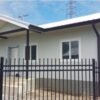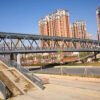The shaped steel structure -skeleton membrane structure
Product description.
A tensioned membrane structure is formed by tensioning membrane material on the structure through tension cables. A tensioned membrane structure can also be called a tensioned cable membrane structure, which is a structural system composed of stable space hyperbolic tensioned membrane surface, supporting mast system, supporting cables and edge cables, etc. The tensioned membrane structure is widely used because of its plasticity and high flexibility and adaptability of the structure. Tensioned membrane structure can be divided into cable net type, ridge cable type, and so on. A tensioned membrane structure system is expressive and has strong structural performance, but the cost is slightly higher and the construction requirements are also high.
A. Characteristics
A membrane structure system consists of a membrane surface, edge and ridge cables, valley cables, supporting structure, anchoring system, and connecting nodes between each part; membrane structure building can be classified by structure into three forms: skeleton membrane structure, tension membrane structure, and inflatable membrane structure; membrane structure can be classified by supporting conditions: flexible supporting structure system, rigid supporting structure system, and mixed supporting structure system.
This project uses a steel structure as the structural skeleton and a tensioned membrane above it. The lower support structure is highly stable, the roof shape is simple, the opening is not easily restricted, and the economic efficiency is high, so it is widely applied to any large or small-scale space.
It is composed of a membrane, steel cables, and pillars, and the cables and pillars are used to introduce tension into the membrane to achieve a stable form.
In addition to creative, innovative, and beautiful shapes, it is also the most effective form of structure to show the spirit of membrane structure.
B. Advantages
Lightweight: The reason for the low weight of tension structures is that they rely on pre-stressed forms rather than materials to maintain structural stability. This results in a much lower self-weight than traditional building structures, but with good stability. Architects can take advantage of its lightweight and large-span characteristics to design and organize the structural detailing to organically unify its light and stable structural properties.
Light transmission: Light transmission is one of the most widely recognized characteristics of modern membrane structures. The light transmission of the membrane can provide the required illumination to the building, which is very important for the energy-saving of the building.
Flexibility: Tensioned membrane structures are not rigid and will deform under wind or snow loads. The membrane structure adapts to the external load by deforming, and in the process, the radius of curvature of the membrane surface in the direction of the load decreases until it can more effectively resist the load.
Sculpture: The unique curved shape of the tensioned membrane structure gives it a strong sculptural appearance. The membrane surface is self-balancing through tension.
Safety: Lightweight tensioned membrane structures designed in accordance with existing national codes and guidelines provide adequate safety. The lightweight structure maintains good stability under horizontal loads such as earthquakes.






